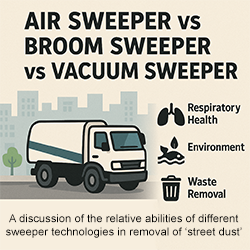Street Dust: Implications for Stormwater and Air Quality, and Environmental Management Through Street Sweeping
A study by Steven J. Calvillo, E. Spencer Williams, and Bryan W. Brooks
Street Dust: Implications for Stormwater and Air Quality, and Environmental Management Through Street SweepingA study by Steven J. Calvillo, E. Spencer Williams, and Bryan W. Brooks |
|
summary by Ranger Kidwell-Ross 
 The linked study is an adaptation of Steven Calvillo's MES thesis summary of a study that examines the history and pick-up up efficiencies of different types of street cleaning technologies by gathering and critiquing past research by other authors. It was published in "Reviews of Environmental Contamination and Toxicology" in 2015.
The linked study is an adaptation of Steven Calvillo's MES thesis summary of a study that examines the history and pick-up up efficiencies of different types of street cleaning technologies by gathering and critiquing past research by other authors. It was published in "Reviews of Environmental Contamination and Toxicology" in 2015.
WorldSweeper hadn't become aware of it until 2025. After reading it we developed the following summary. However, we strongly suggest that you read the actual study, which is at this link. More info about Calvillo, who has worked at TYMCO for 17 years, as well as about his co-authors, is at the bottom of the summary. Overview of Street DustStreet dust comprises particles from motor vehicles (tire debris, emissions), local soils, pavement wear, maintenance sand or road salt, organic debris, and anthropogenic trash. These materials often contain contaminants such as metals, organic pollutants (e.g., PAHs), and nutrients, especially in fine particles (<250 µm), which are readily mobilized by runoff or re-suspended into the air. Street dust thus poses significant risks to both stormwater and air quality. Street Sweeping Technologies
Street Sweeper Pickup Performance TestingThe document reviews empirical and simulated studies comparing sweeper technologies:
Comparative Studies on Sweeper Performance
Overall, high-efficiency regenerative air sweepers consistently showed superior performance for removing small particles critical for environmental protection. Ecological and Human Health Implications
Research Needs IdentifiedThe authors emphasize the need for standardized experimental protocols across studies to allow robust comparisons among sweeping technologies. Current literature lacks consistent methodologies, making definitive conclusions about optimal sweeping strategies or technologies challenging. Conclusions on Sweeping Technologies
However, variability among studies underscores the need for standardized testing to accurately compare sweeper efficiencies under different conditions.
His education credentials include a Master of Environmental Studies (MES) from Baylor University, a Master of Business Administration (MBA) from Tarleton State University, and a Bachelor of Business Administration in Marketing (BBA) with an Undergraduate Certificate in New Product Development (NPD) from the University of North Texas. The adaptation of Calvillo's MES thesis is entitled "Street Dust: Implications for Stormwater and Air Quality, and Environmental Management Through Street Sweeping."

It was co-authored by his mentors, Bryan W. Brooks, PhD, Distinguished Professor of Environmental Science and Biomedical Studies at Baylor University, and E. Spencer Williams, Ph.D., DABT, currently a toxicologist at NASA and former Research Assistant Professor in the Environmental Health Science Program at Baylor University. WorldSweeper offers an award-winning free e-newsletter packed with a variety of information about the power sweeping industry. This includes links to studies and reports, among many other topics. If you do not currently receive the newsletter, use this signup link. |
© 2005 - 2025 World Sweeper
|
Street Contents
|